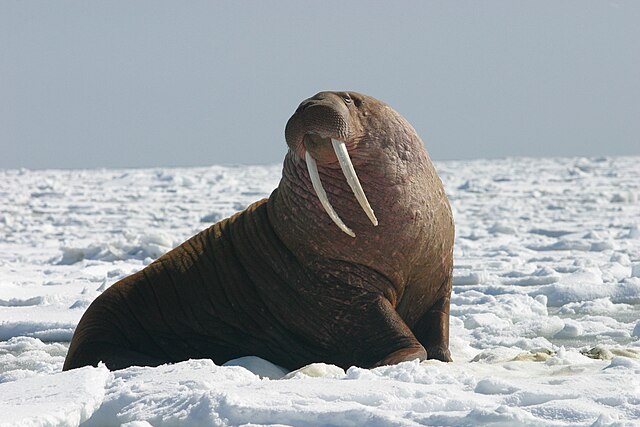nagoyasuzukiamerica.com – The walrus (Odobenus rosmarus) is a captivating marine mammal inhabiting the icy waters of the Arctic and subarctic regions. Recognizable by its prominent tusks, whiskered snout, and bulky body, the walrus plays a vital role in the Arctic ecosystem and holds cultural significance for Indigenous communities. This article explores the fascinating world of the walrus, delving into its unique characteristics, behavior, ecological role, and the challenges it faces in a changing climate.
Physical Characteristics: Distinctive Features of a Marine Giant
The walrus possesses several distinctive physical features that make it easily identifiable:
- Tusks: The most prominent feature of the walrus is its elongated canine teeth, known as tusks. Present in both males and females, these tusks can grow up to a meter long and serve various purposes, including defense, hauling themselves out of the water onto ice or land, and establishing social dominance.
- Whiskers (Vibrissae): The walrus has a dense array of stiff whiskers, or vibrissae, around its snout. These highly sensitive whiskers are crucial for locating prey on the seafloor in murky waters.
- Thick Blubber Layer: A thick layer of blubber beneath the skin insulates the walrus from the frigid Arctic waters and provides an energy reserve.
- Large Body Size: Walruses are among the largest pinnipeds (fin-footed mammals), with males (bulls) being significantly larger than females (cows). Bulls can weigh up to 1,500 kg (3,300 lbs) and measure over 3 meters (10 feet) in length.
- Flippers: Walruses have four flippers that are well-adapted for swimming and maneuvering in the water. They use their front flippers for propulsion and their hind flippers for steering.
Adaptations to the Arctic Environment
Walruses have evolved several key adaptations that enable them to thrive in the harsh Arctic environment:
- Blubber Insulation: The thick blubber layer provides excellent insulation against the cold, keeping the walrus warm in icy waters.
- Slow Heart Rate: When diving, walruses can slow their heart rate significantly, conserving oxygen and allowing them to stay submerged for extended periods.
- Specialized Blood: Their blood has a high oxygen-carrying capacity, further aiding in underwater foraging.
- Social Behavior: Walruses often congregate in large groups (haul-outs) on ice or land, providing warmth and protection.
Behavior and Ecology: Life in the Arctic Waters
Walruses exhibit complex social behaviors and play a crucial role in the Arctic ecosystem:
- Foraging: Walruses are primarily bottom feeders, using their sensitive whiskers to locate prey such as clams, mussels, worms, and other invertebrates on the seafloor. They use powerful jets of water from their mouths to dislodge prey from the sediment.
- Haul-Outs: Walruses regularly haul out onto ice floes, beaches, or rocky shores to rest, socialize, and give birth. These haul-outs can consist of hundreds or even thousands of individuals.
- Social Structure: Walruses are social animals, forming hierarchical groups. Bulls establish dominance hierarchies through displays of aggression and tusk size.
- Reproduction: Walruses have a relatively slow reproductive rate. Females typically give birth to a single calf every two to three years. Calves stay with their mothers for several years, learning essential survival skills.
Subspecies and Distribution
There are two recognized subspecies of walrus:
- Atlantic Walrus (Odobenus rosmarus rosmarus): Found in the Atlantic Ocean, primarily around Greenland, Canada, and Russia.
- Pacific Walrus (Odobenus rosmarus divergens): Found in the Pacific Ocean, primarily in the Bering and Chukchi Seas between Alaska and Russia.
A third, controversial subspecies, the Laptev walrus, has been proposed but is not universally recognized.
Threats and Conservation: Challenges in a Changing Arctic
Walruses face several threats, particularly in the context of a rapidly changing Arctic:
- Climate Change: The most significant threat is the loss of sea ice due to climate change. Sea ice is crucial for walruses as a platform for resting, foraging, and giving birth. Reduced sea ice extent forces walruses to haul out on land in larger numbers, leading to overcrowding and increased risk of stampedes.
- Human Disturbance: Human activities, such as shipping, oil and gas exploration, and tourism, can disturb walrus haul-outs and disrupt their behavior.
- Hunting: While commercial hunting is largely regulated, subsistence hunting by Indigenous communities continues in some areas. Sustainable management of these hunts is important for conservation.
- Ocean Acidification: Increasing ocean acidity due to rising carbon dioxide levels can impact the availability of shellfish, a key food source for walruses.
Conservation Efforts:
Various conservation efforts are in place to protect walrus populations:
- International Agreements: International agreements and collaborations are crucial for managing walrus populations that migrate across international boundaries.
- Protected Areas: Establishing and managing protected areas can help safeguard important walrus habitats.
- Monitoring and Research: Ongoing monitoring and research are essential for understanding walrus populations and the impacts of climate change.
- Community Involvement: Engaging Indigenous communities in conservation efforts is vital, as they possess valuable traditional knowledge about walrus ecology and behavior.
Conclusion:
The walrus is a remarkable creature, perfectly adapted to the challenging Arctic environment. Its iconic tusks, sensitive whiskers, and thick blubber layer are testaments to its unique evolutionary history. However, the walrus faces significant challenges in a rapidly changing Arctic. Protecting this iconic species requires concerted conservation efforts, including addressing climate change, minimizing human disturbance, and promoting sustainable management practices.
